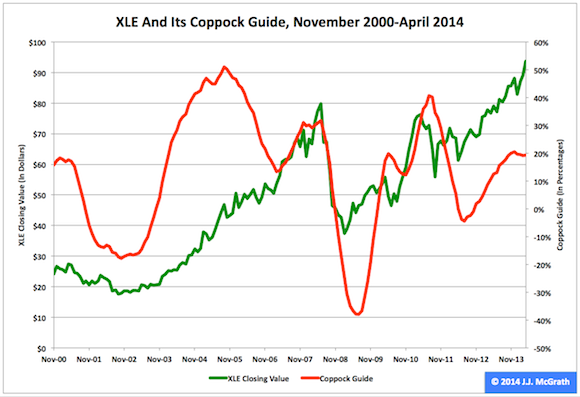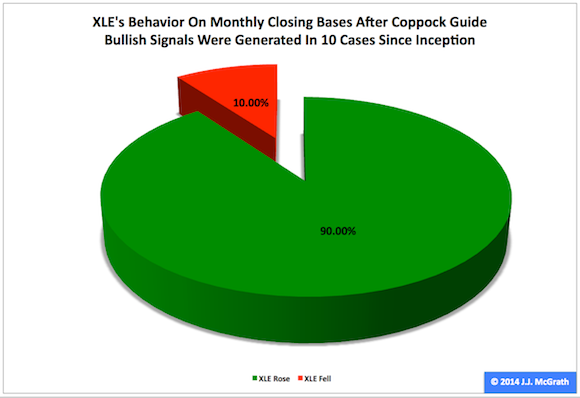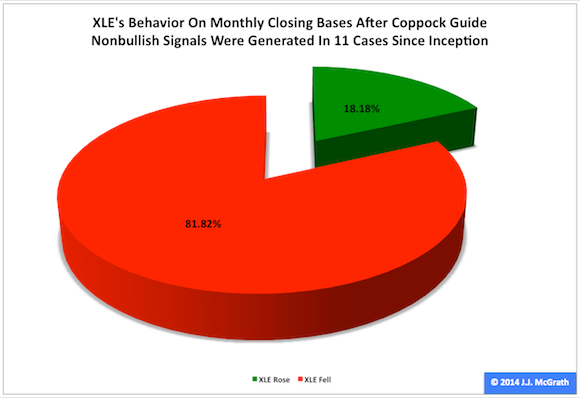Over this period, XLE’s return was a little less than
one-half that of the Utilities SPDR ETF (XLU) and a lot more than twice
that of the SPDR S&P 500 ETF (SPY),
as detailed in “XLU Coppock Guide: Bullish as of
May Day 2014.” (XLU returned 14.74 percent, and SPY returned 2.41 percent.)
XLE is the second of 13 ETFs to be featured in a J.J.’s Risky
Business blog series this month. Basically, I will be looking at each
ETF with both eyes fixed on its Coppock guide, as was the case in “SPY Coppock Guide: Away From Bullishness, Toward
Nonbullishness as of March 31, 2014.”
The Coppock guide, aka either the Coppock curve or the Coppock
indicator, is a long-term indicator of price movements in major stock-market
indexes introduced by Edwin S. Coppock in Barron’s
more than half a century ago. The indicator’s history and methodology
are interesting in themselves, but my focus now is on its relevance to XLE.
Figure 1: XLE And Its
Coppock Guide, The Complete History
Note: The XLE
closing-value scale is on the left, and the Coppock guide scale is on the
right.
Source: This J.J.’s
Risky Business chart is based on
proprietary analyses of Yahoo Finance adjusted monthly share-price data and those data themselves.
Coppock developed his long-term guide not to flash both
bullish and bearish signals but to generate only bullish signals. However, I
employ it to flash either bullish or nonbullish signals. It is extremely
important to keep in mind that a nonbullish signal is not equivalent to a bearish signal in the context of the Coppock
guide.
I anticipate XLE may advance after a bullish signal and
expect it might do anything following a nonbullish signal (i.e., trade higher,
lower or sideways).
Figure 2: XLE’s
Behavior Subsequent To Initial Bullish Signals
Source: This J.J.’s
Risky Business chart is based on
proprietary analyses of Yahoo Finance adjusted monthly share-price data.
The XLE Coppock guide’s initial bullish signals collectively
have done an excellent job in forecasting the future upward movements of the
ETF on monthly closing bases. In 10 cases since November 2000, these signals
have been correct on nine occasions, or 90.00 percent of the time, and incorrect
on one occasion, or 10.00 percent of the time.
The Coppock guide’s latest initial bullish signal was
generated in March, when XLE’s closing share price was $89.06. Because of a
one-month lag in the confirmation of any signal, however, I will be unable to
determine the success or failure of this most recent signal until the close of
trading May 30.
Meanwhile, I believe the equity market may be within a few
percentage points of a long-term peak (as indicated in “SPY, MDY And IJR At The Fed's QE3+ Market Top”),
and I think SPY is experiencing not tailwinds but headwinds in the short term
(as suggested in “SPY Seasonality: Share Price
Cools Down While U.S. Air Temperature Heats Up”).
Accordingly, I would be completely unsurprised by a certain
amount of whipsawing between the XLE Coppock guide’s bullish and nonbullish signals
in the second and third quarters of this year. This behavior would be
uncharacteristic, but there is historical precedent for it in proximity to a
market top: Incredibly, the XLE Coppock guide flashed signals in each of the
four months between December 2007 and March 2008, and it generated a fifth
signal shortly afterward, in June 2008.
Figure 3: XLE’s
Behavior Subsequent To Initial Nonbullish Signals
Source: This J.J.’s
Risky Business chart is based on
proprietary analyses of Yahoo Finance adjusted monthly share-price data.
The XLE Coppock guide’s initial nonbullish signals collectively also
have established an interesting track record when evaluated on monthly closing bases.
Again, it is extremely important to keep in mind that a nonbullish signal is not equivalent to a bearish signal in
the context of the Coppock guide. In the wake of nonbullish signals since November
2000, however, the ETF has fallen on nine occasions, or 81.82 percent of the
time, and risen on two occasions, or 18.18 percent of the time.
A day without analysis of the nine Select Sector SPDRs by
multiple short-term indicators (e.g., price, relative strength, money flow)
would be like a day without sunshine at my shop, and examinations of their
long-term indicators, such as their Coppock guides, are also invaluable as I
seek more light than heat about the state of the stock market.
Coppock Guide: The
Blog Series
Author’s Note: This is
the second blog post in a series centered on the Coppock guides of 13 important
ETFs in May. The first was cross-posted at both J.J.’s Risky
Business and J.J. McGrath’s
Instablog on Seeking Alpha, but the rest of
the series will be posted at the former location. You can follow me (and the
series) @JJMcGrath3000 on Twitter, at JJMcGrath on StockTwits and via myself on Google+.
Disclaimer: The opinions
expressed herein by the author do not constitute an investment recommendation,
and they are unsuitable for employment in the making of investment decisions.
The opinions expressed herein address only certain aspects of potential
investment in any securities and cannot substitute for comprehensive investment
analysis. The opinions expressed herein are based on an incomplete set of
information, illustrative in nature, and limited in scope. In addition, the
opinions expressed herein reflect the author’s best judgment as of the date of
publication, and they are subject to change without notice.



No comments:
Post a Comment